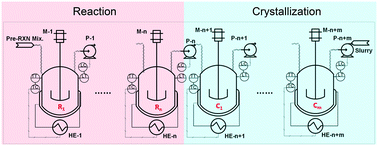当前位置:
X-MOL 学术
›
React. Chem. Eng.
›
论文详情
Our official English website, www.x-mol.net, welcomes your feedback! (Note: you will need to create a separate account there.)
Development of an automated multi-stage continuous reactive crystallization system with in-line PATs for high viscosity process†
Reaction Chemistry & Engineering ( IF 3.9 ) Pub Date : 2018-07-03 00:00:00 , DOI: 10.1039/c8re00078f Chuntian Hu 1, 2, 3 , Joshua E. Finkelstein 1, 2, 3 , Wei Wu 1, 2, 3 , Khrystyna Shvedova 1, 2, 3 , Christopher J. Testa 1, 2, 3 , Stephen C. Born 1, 2, 3 , Bayan Takizawa 1, 2, 3 , Thomas F. O'Connor 3, 4, 5 , Xiaochuan Yang 3, 4, 5 , Sukumar Ramanujam 6, 7, 8, 9 , Salvatore Mascia 1, 2, 3
Reaction Chemistry & Engineering ( IF 3.9 ) Pub Date : 2018-07-03 00:00:00 , DOI: 10.1039/c8re00078f Chuntian Hu 1, 2, 3 , Joshua E. Finkelstein 1, 2, 3 , Wei Wu 1, 2, 3 , Khrystyna Shvedova 1, 2, 3 , Christopher J. Testa 1, 2, 3 , Stephen C. Born 1, 2, 3 , Bayan Takizawa 1, 2, 3 , Thomas F. O'Connor 3, 4, 5 , Xiaochuan Yang 3, 4, 5 , Sukumar Ramanujam 6, 7, 8, 9 , Salvatore Mascia 1, 2, 3
Affiliation

|
An automated multi-stage continuous reaction system with in-line PATs for a high viscosity reactive crystallization process was developed in the present study. Data acquisition (DAQ) hardware and Labview software were used as the local control system. A “forward-backward” burst pumping strategy was developed to smoothly transfer the highly viscous hot slurry from one vessel to the next. In addition, a comparative analysis between a plug flow reactor (PFR) and continuous stirred-tank reactors (CSTRs) in series revealed that to achieve the same conversion, the latter would require more volume than the former, but less than a single CSTR. For a second-order reaction, the value of the Damköhler number necessary to achieve conversion of 90.0% in a single CSTR is 90. Thus, it is reasonable to approximate a PFR using CSTRs in series to obtain a high yield with a smaller reaction volume (compared with a single CSTR). As the probes could not be positioned in the hot slurry due to fouling issues, in-line focused beam reflectance measurement (FBRM) and React IR were used to monitor the crystal size and reactant concentration in the vessel containing the cold slurry. E-factors of batch and continuous processes were also compared and the continuous reaction could obtain a lower E-factor because less waste was generated.
中文翻译:

开发具有在线PAT的自动化多级连续反应结晶系统,用于高粘度工艺†
在本研究中,开发了具有在线PATs的自动化多级连续反应系统,用于高粘度反应结晶过程。数据采集(DAQ)硬件和Labview软件被用作本地控制系统。制定了“向前-向后”爆破泵送策略,以将高粘度热浆从一个容器顺利转移到另一个容器。另外,在串联的活塞流反应器(PFR)和连续搅拌釜反应器(CSTR)之间进行的比较分析表明,要实现相同的转化率,后者将比前者需要更多的体积,但少于单个CSTR。对于二阶反应,在单个CSTR中实现90.0%转化所必需的Damköhler数的值为90。因此,因此,合理的方法是串联使用CSTR来近似PFR,以获得高收率和较小的反应体积(与单个CSTR相比)。由于探针由于结垢问题而无法放置在热浆液中,因此使用在线聚焦光束反射率测量(FBRM)和React IR来监测包含冷浆液的容器中的晶体尺寸和反应物浓度。E-因素分批和连续过程也进行了比较,该连续反应可以得到较低的E-因子因为产生更少的废物。
更新日期:2018-07-03
中文翻译:

开发具有在线PAT的自动化多级连续反应结晶系统,用于高粘度工艺†
在本研究中,开发了具有在线PATs的自动化多级连续反应系统,用于高粘度反应结晶过程。数据采集(DAQ)硬件和Labview软件被用作本地控制系统。制定了“向前-向后”爆破泵送策略,以将高粘度热浆从一个容器顺利转移到另一个容器。另外,在串联的活塞流反应器(PFR)和连续搅拌釜反应器(CSTR)之间进行的比较分析表明,要实现相同的转化率,后者将比前者需要更多的体积,但少于单个CSTR。对于二阶反应,在单个CSTR中实现90.0%转化所必需的Damköhler数的值为90。因此,因此,合理的方法是串联使用CSTR来近似PFR,以获得高收率和较小的反应体积(与单个CSTR相比)。由于探针由于结垢问题而无法放置在热浆液中,因此使用在线聚焦光束反射率测量(FBRM)和React IR来监测包含冷浆液的容器中的晶体尺寸和反应物浓度。E-因素分批和连续过程也进行了比较,该连续反应可以得到较低的E-因子因为产生更少的废物。



























 京公网安备 11010802027423号
京公网安备 11010802027423号